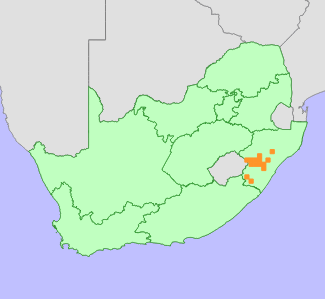|
Scientific Name | Nerine pancratioides Baker |
Higher Classification | Monocotyledons |
Family | AMARYLLIDACEAE |
Synonyms | Nerine schlechteri Baker |
Common Names | White Nerine (e) |
National Status |
Status and Criteria | Near Threatened B1ab(ii,iii,iv,v) |
Assessment Date | 2015/04/23 |
Assessor(s) | H. Mtshali & L. von Staden |
Justification | EOO 11 200 km², occurs in small, isolated subpopulations in wetlands and is declining as a result of afforestation, overgrazing and trampling by livestock and alien plant invasion. It is estimated that between 10 and 15 locations remain. |
Distribution |
Endemism | South African endemic |
Provincial distribution | KwaZulu-Natal |
Range | Giant's Castle to Greytown and Kokstad. |
Habitat and Ecology |
Major system | Terrestrial |
Major habitats | Midlands Mistbelt Grassland, Mooi River Highland Grassland, Drakensberg Foothill Moist Grassland, Northern Drakensberg Highland Grassland |
Description | Wetlands and streambanks in high-lying areas. |
Threats |
| This species has been impacted by extensive habitat loss, particularly in the KwaZulu-Natal Midlands, where only small fragments of mistbelt and moist grassland remains as a result of urban expansion, agriculture and establishment of timber plantations. Remaining subpopulations are threatened by ongoing habitat loss and degradation, particularly wetland degradation due to overgrazing, damming and alien plant invasion. |
Population |
Nerine pancratioides is known from a large number of historical records. In many of these areas, particularly in the KwaZulu-Natal Midlands, where very little of its mistbelt grassland habitat remains intact, it is not certain whether the subpopulations persist, and field surveys as still needed to relocate them. This species has been recently confirmed to persist at six locations, mostly in the central and southern KwaZulu-Natal Drakensberg foothills.
|
Population trend | Decreasing |
Assessment History |
Taxon assessed |
Status and Criteria |
Citation/Red List version | | Nerine pancratioides Baker | NT B1ab(ii,iii,iv,v) | 2015.1 | | Nerine pancratioides Baker | VU B1ab(ii,iii,iv,v) | Raimondo et al. (2009) | | Nerine pancratioides Baker | Lower Risk - Least Concern | Victor (2002) | | Nerine pancratioides Baker | Not Threatened | Hilton-Taylor (1996) | | Nerine pancratioides Baker | Uncertain | Hall et al. (1980) | |
Bibliography |
Baker, J.G. 1896. Amaryllideae. In: W.T. Thiselton-Dyer (ed). Flora Capensis VI (Haemodoraceae to Liliaceae):171-246. L. Reeve & Co., London.
Craib, C. 2004. Nerine pancratioides. Degradation of grassland habitats by exotic plantations are threatening the beautiful white Nerine with extinction. Veld & Flora 90:105-107.
Hall, A.V., De Winter, M., De Winter, B. and Van Oosterhout, S.A.M. 1980. Threatened plants of southern Africa. South African National Scienctific Programmes Report 45. CSIR, Pretoria.
Hilton-Taylor, C. 1996. Red data list of southern African plants. Strelitzia 4. South African National Botanical Institute, Pretoria.
Norris, C.A. 1974. The genus Nerine. The Nerine Society Bulletin 6:7-31.
Pooley, E. 2003. Mountain flowers: a field guide to the flora of the Drakensberg and Lesotho. Natal Flora Publications Trust, Durban.
Raimondo, D., von Staden, L., Foden, W., Victor, J.E., Helme, N.A., Turner, R.C., Kamundi, D.A. and Manyama, P.A. 2009. Red List of South African Plants. Strelitzia 25. South African National Biodiversity Institute, Pretoria.
Victor, J.E. 2002. South Africa. In: J.S. Golding (ed), Southern African plant Red Data Lists. Southern African Botanical Diversity Network Report 14 (pp. 93-120), SABONET, Pretoria.
|
Citation |
| Mtshali, H. & von Staden, L. 2015. Nerine pancratioides Baker. National Assessment: Red List of South African Plants version 2024.1. Accessed on 2025/10/26 |
 Comment on this assessment
Comment on this assessment

